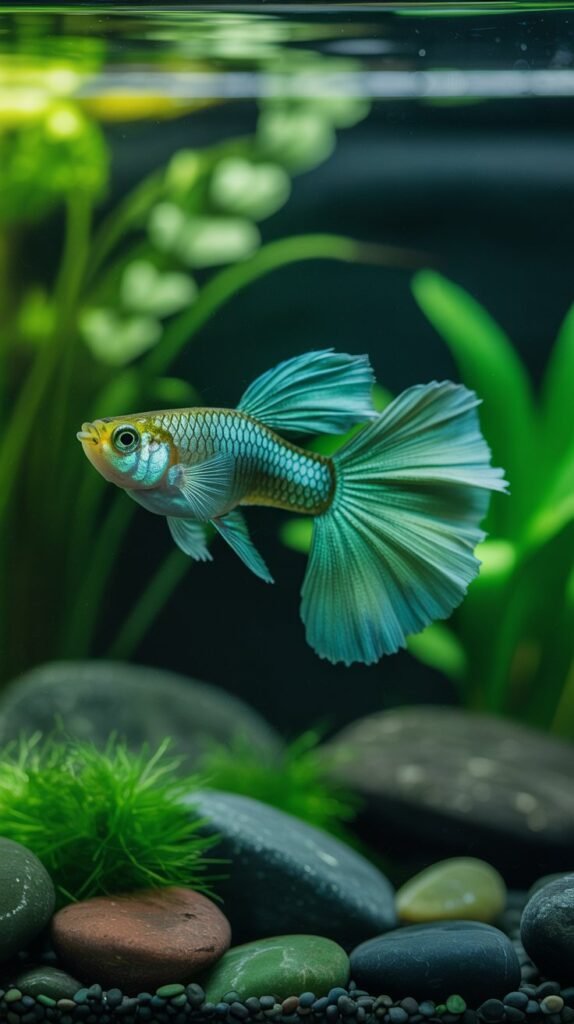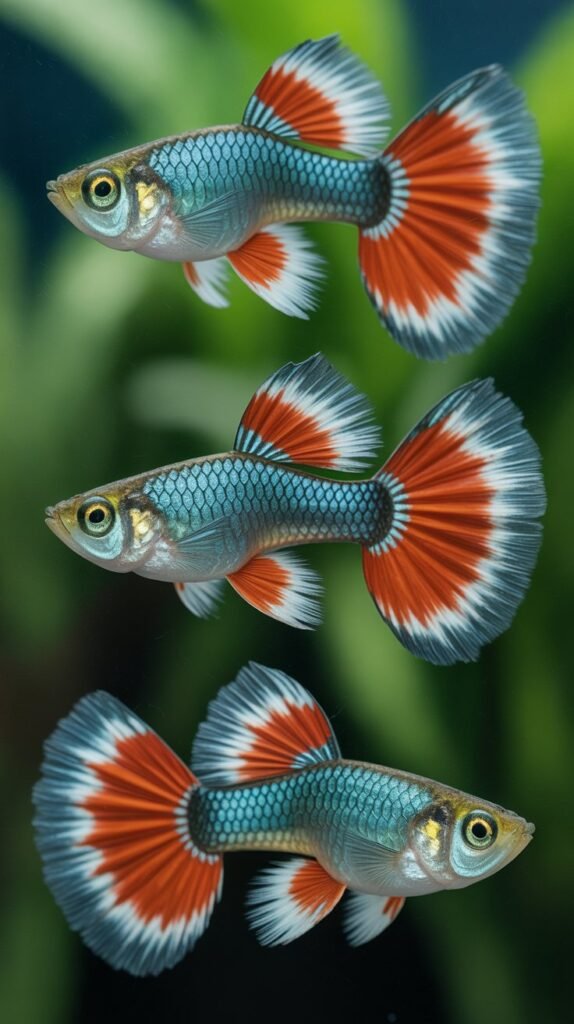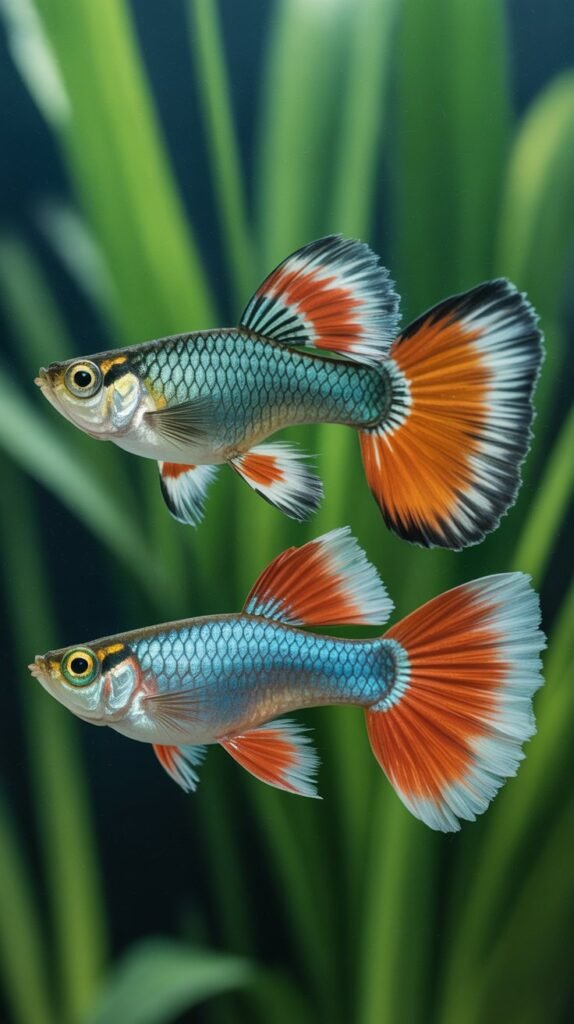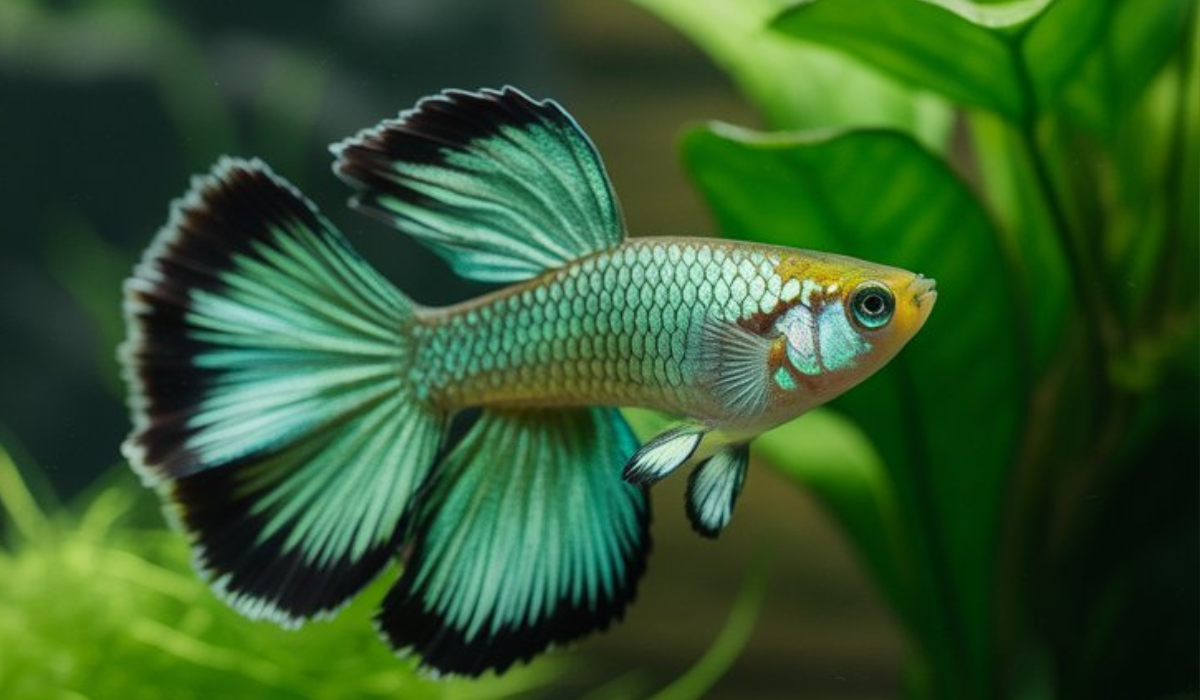Among the many mesmerizing guppy varieties that grace aquariums worldwide, the Vienna Emerald Guppy stands out as a true gem. Known for its iridescent green hues, graceful movements, and peaceful nature, this fish captures the heart of both beginner and advanced aquarists alike. The Vienna Emerald Guppy embodies beauty, simplicity, and vitality — a perfect example of why guppies are called “the jewels of the aquarium.”
In this complete guide, we’ll explore everything about the Vienna Emerald Guppy — from its origins, physical traits, and behavior, to breeding, feeding, and care tips — to help you maintain a vibrant and healthy guppy colony.
🌍 Origin and History of the Vienna Emerald Guppy
The Vienna Emerald Guppy traces its roots back to selective breeding programs in Europe, particularly in Vienna, Austria. Breeders aimed to produce a guppy with deep green metallic tones that shimmer like an emerald gemstone under aquarium lighting.
The Emerald Guppy strain originates from the Poecilia reticulata species — the common guppy, native to freshwater streams and rivers of South America, particularly in Venezuela, Brazil, and Guyana. Over time, guppies were introduced to many parts of the world for mosquito control and ornamental purposes, leading to countless color and fin variations.

The Vienna Emerald Guppy became especially popular in the 1990s among European breeders and has since become a favorite among aquascaping enthusiasts worldwide due to its striking appearance and adaptability.
💎 Physical Appearance of the Vienna Emerald Guppy
The Vienna Emerald Guppy is celebrated for its unique emerald-green sheen that glows vividly under both natural and artificial light. This metallic coloration is usually concentrated along the body’s midline, extending from the head to the caudal peduncle.
✨ Key Features:
- Coloration:
The dominant green coloration often reflects hints of blue, turquoise, and gold, creating a multi-tonal, shimmering effect. Males are more intensely colored, while females have a subtler hue with translucent bodies. - Fins:
The tail (caudal fin) and dorsal fin are usually large and flowing, sometimes exhibiting mosaic or lace-like patterns. Variants can include delta, veil, or lyretail shapes depending on breeding lines. - Size:
Males typically grow up to 1.5 inches (3.8 cm), while females reach 2.5 inches (6.3 cm). Despite their small size, their presence in the tank is captivating. - Body Shape:
Sleek, torpedo-shaped bodies allow for agile swimming, making them one of the most graceful guppy varieties. - Sexual Dimorphism:
Males are smaller, more colorful, and possess a gonopodium (modified anal fin for mating), while females are larger with rounder bellies and a gravid spot when pregnant.
🌈 Behavior and Temperament
Vienna Emerald Guppies are known for their peaceful, playful, and social nature. They thrive in community tanks and are rarely aggressive, making them perfect companions for other small, non-aggressive fish.
Behavioral Traits:
- Schooling Fish: They prefer to swim in groups, which enhances their natural display and reduces stress.
- Active Swimmers: Constantly darting around the tank, they add life and motion to any aquarium.
- Friendly Nature: Compatible with tetras, mollies, platies, and Corydoras catfish.
- Curiosity: They interact with their surroundings and often follow your movements outside the tank.
🏡 Ideal Aquarium Setup for Vienna Emerald Guppies
A well-designed tank not only keeps your guppies healthy but also brings out their best coloration.
✅ Recommended Tank Conditions:
| Parameter | Ideal Range |
|---|---|
| Tank Size | Minimum 10 gallons for a small colony |
| Temperature | 72°F – 82°F (22°C – 28°C) |
| pH Level | 6.8 – 7.8 |
| Water Hardness | 8 – 12 dGH |
| Filtration | Gentle, with a sponge or internal filter |
| Lighting | Moderate to bright (enhances green shimmer) |
🪴 Aquascaping Tips:
- Use fine gravel or sand substrate.
- Add live plants such as Java Moss, Anubias, and Guppy Grass for hiding and breeding.
- Incorporate floating plants to diffuse light and mimic their natural habitat.
- Ensure gentle water flow to prevent fin damage.
💧 Water Quality Maintenance:
Regular water changes (25–30% weekly) are crucial. Vienna Emerald Guppies are hardy, but sudden changes in water chemistry can cause stress or illness. Always dechlorinate tap water and maintain stable conditions.
Feeding the Vienna Emerald Guppy

A balanced diet is essential to maintain the vivid emerald coloration and overall vitality of your guppies.
🥬 Diet Composition:
- High-Quality Flakes or Pellets:
Look for fish food specially formulated for guppies or tropical fish, enriched with spirulina and carotenoids. - Live and Frozen Foods:
Offer daphnia, brine shrimp, mosquito larvae, or bloodworms once or twice a week to boost protein intake. - Vegetable Matter:
Add blanched spinach, zucchini, or algae wafers to provide essential fibers and improve digestion. - Feeding Frequency:
Feed 2–3 small meals daily. Only provide what they can consume in 2–3 minutes to prevent overfeeding and water pollution.
💡 Tip:
For optimal coloration, alternate between high-protein live foods and color-enhancing flakes. A varied diet keeps them vibrant and active.
❤️ Breeding Vienna Emerald Guppies
One of the best parts about keeping guppies is their ease of breeding. The Vienna Emerald Guppy is no exception — it breeds readily under favorable conditions.
🐟 Breeding Setup:
- Tank Size: 10–20 gallons
- Temperature: Around 78°F (25°C)
- Plants: Provide dense vegetation (like Java Moss) for fry hiding spaces.
- Ratio: 1 male : 2-3 females to prevent female exhaustion.
🐣 The Reproductive Process:
Guppies are livebearers, meaning females give birth to live young instead of laying eggs. After mating, the gestation period lasts about 21–30 days. A single female can give birth to 20–60 fry at a time.
👶 Fry Care:
- Move pregnant females to a separate breeding tank before delivery.
- Once fry are born, remove the female to prevent predation.
- Feed fry with infusoria, baby brine shrimp, or crushed flakes several times a day.
- After two weeks, they can gradually be introduced to the main tank.
🧬 Breeding for Color:
To maintain the signature emerald green trait, only breed guppies displaying intense green coloration and strong fin structure. Avoid crossbreeding with other guppy strains to preserve purity.
⚕️ Health and Common Diseases
While Vienna Emerald Guppies are hardy, they can still fall victim to common freshwater diseases if water quality or diet is poor.
🩺 Common Issues:
- Ich (White Spot Disease):
Caused by parasites; symptoms include white dots on fins and body.
Treatment: Increase water temperature slightly and use anti-parasitic medication. - Fin Rot:
Resulting from bacterial infection, often due to poor water quality.
Treatment: Use antibacterial fish medicine and improve filtration. - Swim Bladder Disorder:
Affects buoyancy, making fish swim abnormally.
Treatment: Fast for 24 hours and then feed a cooked pea (without skin). - Velvet Disease:
Gives a golden, dusty appearance to the skin.
Treatment: Use copper-based medication and dim lighting.
🧼 Prevention Tips:
- Maintain stable water parameters.
- Avoid overcrowding.
- Quarantine new fish before adding to the main tank.
- Feed a balanced diet.
- Perform regular tank maintenance.
Interesting Facts About Vienna Emerald Guppies
- The shimmering green coloration appears metallic under LED lighting, enhancing their aquarium appeal.
- Males perform courtship dances to attract females, displaying their fins in elegant movements.
- They have an average lifespan of 2–3 years, but with optimal care, some live up to 5 years.
- Guppies can store sperm, allowing females to give birth multiple times after a single mating.
- Their genetic diversity makes them a popular choice for experimental breeding and color development.
Tank Mates for Vienna Emerald Guppies

Since they are peaceful, the Vienna Emerald Guppy fits beautifully into community tanks. However, choose companions wisely to avoid fin-nipping or stress.
🐠 Compatible Tank Mates:
- Neon Tetras
- Platies
- Mollies
- Endler’s Livebearers
- Corydoras Catfish
- Zebra Danios
- Shrimp (like Amano or Cherry Shrimp)
- Snails (Nerite or Mystery Snails)
- Avoid:
- Aggressive or fin-nipping fish such as Tiger Barbs, Betta fish, or Cichlids.
Enhancing Coloration and Display
To bring out the full brilliance of your Vienna Emerald Guppy, consider the following:
- Use Dark Substrate: Enhances the contrast of the green color.
- LED Lighting: Install adjustable aquarium lights with cool white or blue tones.
- Live Plants: Provide natural contrast and oxygenation.
- Quality Diet: Feed color-enhancing foods rich in carotenoids and spirulina.
- Minimal Stress: Keep tankmates peaceful and water parameters stable.
Why Choose the Vienna Emerald Guppy?
If you’re looking for a guppy that combines elegance, color, and personality, the Vienna Emerald Guppy is an exceptional choice.Key Benefits:
- Vibrant metallic green hues
- Hardy and adaptable to various conditions
- Peaceful temperament suitable for community tanks
- Easy to breed and care for
- Adds visual richness to aquascaped tanks
Whether you’re a beginner aquarist or a seasoned hobbyist, these guppies offer unmatched visual appeal and fascinating behavior.
Frequently Asked Questions (FAQs)
1. What makes the Vienna Emerald Guppy unique?
Its vivid emerald-green coloration with metallic shimmer distinguishes it from other guppy strains. It’s both rare and visually stunning.
2. How big do Vienna Emerald Guppies grow?
Males grow up to 1.5 inches, and females can reach 2.5 inches in length.
3. Can Vienna Emerald Guppies live with other fish?
Yes. They’re peaceful and get along well with other small, calm fish species like tetras, mollies, and Corydoras.
4. What do Vienna Emerald Guppies eat?
They enjoy a varied diet of flakes, pellets, live or frozen foods (like brine shrimp and daphnia), and some vegetables.
5. Are Vienna Emerald Guppies easy to breed?
Yes. They are livebearers and breed easily in home aquariums. Ensure a 1:2 male-to-female ratio and provide hiding spots for fry.
6. How long do they live?
Typically, 2–3 years, but with excellent care, they can live longer.
7. What is the ideal tank size?
A 10-gallon tank is the minimum for a small group. Larger tanks allow more swimming space and better water stability.
8. How do I enhance their coloration?
Provide bright lighting, a nutrient-rich diet, and a clean, stress-free environment.
9. Can I mix Vienna Emerald Guppies with other guppy strains?
It’s possible, but crossbreeding may dilute their emerald color. For maintaining pure strains, breed within the same variety.
10. Are they suitable for beginners?
Absolutely. Their hardiness, peaceful nature, and beauty make them one of the best fish for beginners.
Final Thoughts
The Vienna Emerald Guppy truly lives up to its name — a living emerald that transforms any aquarium into a radiant underwater landscape. Its combination of hardiness, brilliance, and charm makes it an ideal choice for aquarists at all levels. Whether you’re looking to breed guppies or simply enjoy their dazzling colors, this fish is a stunning addition to your aquatic family.
With proper care, nutrition, and attention to water quality, your Vienna Emerald Guppies will reward you with beauty, liveliness, and endless fascination for years to come.

